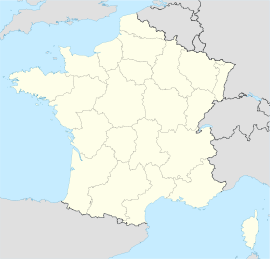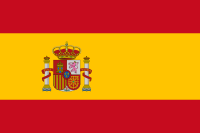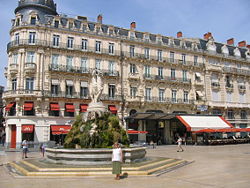Montpellier
|
Commune of Montpellier |
|
| Location | |
 Montpellier
|
|
| Administration | |
|---|---|
| Country | France |
| Region | Languedoc-Roussillon |
| Department | Hérault |
| Arrondissement | Montpellier |
| Intercommunality | Montpellier |
| Mayor | Hélène Mandroux-Colas (2008-2014) |
| Statistics | |
| Elevation | 7–57 m (avg. 27 m) |
| Land area¹ | 56.88 km² |
| Population² (1999) |
225,392 |
| - Ranking | 8th in France |
| - Density | 3963/km² (1999) |
| Miscellaneous | |
| INSEE/Postal code | 34172/ 34000, 34070, 34080, 34090 |
| 1 French Land Register data, which excludes lakes, ponds, glaciers > 1 km² (0.386 sq mi or 247 acres) and river estuaries. | |
| 2 Population sans doubles comptes: residents of multiple communes (e.g., students and military personnel) only counted once. | |
Montpellier (Occitan: Montpelhièr) is a city in the south of France. It is the capital of the Languedoc-Roussillon region, as well as the Hérault department.
Contents |
Population
The population of the (commune) of Montpellier at the 1999 census was 225,392, whereas the whole metropolitan area had a population of 459,916 in 1999. In 2005, it was estimated that the population of the city of Montpellier had reached 248,000[1]. In 2008, the estimated population of the metropolitan area was 533,000.
Geography

The city is situated on hilly ground 10 km (6 miles) inland from the Mediterranean coast on the River Lez. The name of the city, originally Monspessulanus, is said to have stood for mont pelé (the naked hill, because the vegetation was poor), or le mont de la colline (the mount of the hill)
History
Ancient
Montpellier is one of the few large cities in France without a (Gallo-)Roman background.
Medieval period

In the Early Middle Ages, the nearby episcopal town of Maguelone was the major settlement in the area, but raids by pirates encouraged settlement a little further inland. Montpellier, first mentioned in a document of 985, was founded under a local feudal dynasty, the Guillem counts of Toulouse, who joined together two hamlets, built a castle and walls around the settlement. The two surviving towers of the city walls, the Tour des Pins and the Tour de la Babotte are later in date, however. Montpellier came to prominence in the 10th century as a trading centre, with trading links across the Mediterranean world and a rich Jewish cultural life and traditions of tolerance of its Muslims, Jews and Cathars— and later of its Protestants. William VII of Montpellier established a faculty of medicine in 1180, recognised by Pope Nicholas IV; the city's university was established in 1220 and was one of the chief centers for the teaching of medicine. This marked the high point of Montpellier's prominence. The city became a possession of the kings of Aragon in 1213 by the marriage of Peter II of Aragon with Marie of Montpellier, who brought the city as her dowry. Montpellier gained a charter in 1204 when Peter and Marie confirmed the city's traditional freedoms and granted the city the right to choose twelve governing consuls annually. Montpellier remained a possession of the crown of Aragon until it passed to James III of Majorca, who sold the city to the French king Philip VI in 1349, to raise funds for his ongoing struggle with Peter IV of Aragon. In the 14th century, Montpellier gained a church (not yet a cathedral) dedicated to Saint Peter, noteworthy for its very unusual porch supported by two high, somewhat rocket-like towers. With its importance steadily increasing, the city finally gained a bishop, who moved from Maguelone in 1536 and sat in the neighbouring community of Montpelliéret (eventually absorbed into Montpellier proper). In 1432, Jacques Coeur established himself in the city and it became an important economic centre, until 1481 when Marseille took over this role.
After the Reformation
At the time of the Reformation in the sixteenth century, many of the inhabitants of Montpellier became Protestants (or Huguenots as they were known in France) and the city became a stronghold of Protestant resistance to the Catholic French crown. In 1622, King Louis XIII besieged the city and took it after eight months, building the Citadel of Montpellier to secure it. Louis XIV made Montpellier capital of Bas Languedoc, and the town started to embellish itself, by building the Promenade du Peyrou, the Esplanade and a large number of houses in the historic centre. After the French Revolution, the city became the capital of the much smaller Hérault.
Modern history

During the 19th century the city developed into an industrial centre. In the 1960s, its population grew dramatically after French settlers in Algeria were resettled in the city following Algeria's independence from France. In the 1980s and 1990s, the city drew attention with a number of major redevelopment projects, such as the Corum and especially the Antigone District.
Lords of Montpellier
- William I of Montpellier (d. 1019)
- William II of Montpellier (d. 1025)
- William III of Montpellier (d. 1058)
- William IV of Montpellier (d. 1068)
- William V of Montpellier (d. 1120)
- William VI of Montpellier (d. 1149)
- William VII of Montpellier (d. 1179)
- William VIII of Montpellier (d. 1202)
- Marie of Montpellier (d. 1219)
- and King Peter II of Aragon (d. 1213)
- James I of Aragon (d. 1276)
- James II of Majorca (d. 1311)
Main sights
- The main focus point of the city is the Place de la Comédie.

- The Musée Fabre
- In the historic centre, a significant number of Hôtels can be found.
- A fine botanical garden, the first in France, founded in 1593
- The 14th century Saint Pierre Cathedral


- The Porte du Peyrou, a triumphal arch
- The Saint Clément Aqueduct
- The Antigone District and other housing projects have been designed by the architect Ricardo Bofill from Catalonia, Spain
- A number of châteaux, so-called follies, built by wealthy merchants surround the city
Education
The University of Montpellier is one of the oldest in the World, 1160, having been granted a charter in 1220 by Cardinal Conrad von Urach and confirmed by Pope Nicholas IV in a papal bull of 1289. It was suppressed during the French Revolution but was re-established in 1896.
It is not known exactly at what date the schools of literature were founded which developed into the Montpellier faculty of arts; it may be that they were a direct continuation of the Gallo-Roman schools. The school of law was founded by Placentinus, a doctor from Bologna university, who came to Montpellier in 1160, taught there during two different periods, and died there in 1192. The school of medicine was founded perhaps by a graduate of the Spanish medical schools; it is certain that, as early as 1137, there were excellent physicians at Montpellier. The statutes given in 1220 by Cardinal Conrad, legate of Honorius III, which were completed in 1240 by Pierre de Conques, placed this school under the direction of the Bishop of Maguelonne. Pope Nicholas IV issued a Bull in 1289, combining all the schools into a university, which was placed under the direction of the bishop, but which in fact enjoyed a large measure of autonomy.
Theology was at first taught in the convents, in which St. Anthony of Padua, Raymond Lullus, and the Dominican Bernard de la Treille lectured. Two letters of King John prove that a faculty of theology existed at Montpellier independently of the convents, in January, 1350. By a Bull of 17 December, 1421, Martin V granted canonical institution to this faculty and united it closely with the faculty of law. In the sixteenth century the faculty of theology disappeared for a time, when Calvinism, in the reign of Henry II of France, held complete possession of the city. It resumed its functions after Louis XIII had reestablished the royal power at Montpellier in 1622; but the rivalries of Dominicans and Jesuits interfered seriously with the prosperity of the faculty, which disappeared at the Revolution. The faculty numbered among its illustrious pupils of law Petrarch, who spent four years at Montpellier, and among its lecturers Guillaume de Nogaret, chancellor to Philip the Fair, Guillaume de Grimoard, afterwards pope under the name of Urban V, and Pedro de Luna, antipope as Benedict XIII. But after the 15th century this faculty fell into decay, as did also the faculty of arts, although for a time, under Henry IV of France, the latter faculty had among its lecturers Casaubon. The Montpellier school of medicine owed its success to the ruling of the Guilhems, lords of the town, by which any licensed physician might lecture there; there was no fixed limit to the number of teachers, lectures were multiplied, and there was a great wealth of teaching. Rabelais took his medical degrees at Montpellier. It was in this school that the biological theory of vitalism, elaborated by Barthez (1734-1806), had its origin. The French Revolution did not interrupt the existence of the faculty of medicine. The faculties of science and of letters were re-established in 1810; that of law in 1880. It was on the occasion of the sixth centenary of the university, celebrated in 1889, that the Government of France announced its intention -- which has since been realized -- of reorganizing the provincial universities in France.
Transport


Montpellier is served by railway, including TGV trains. Montpellier's main railway station is St Roch.
The Montpellier-Méditerranée Airport is located in the area of Fréjorgues, in the town of Mauguio, southeast of Montpellier.
The TaM (Transports de l'agglomération de Montpellier) manages the city's public transportation, including its tramway network consisting of 2 lines and several parking facilities. Line 1 runs from Mosson in the west to Odysseum in the east. Line 2 runs from Jacou in the northeast to St. Jean-de-Vedas in the southwest. They intersect at Gare St. Roch station, Place de l'Europe and again in front of the Corum. Work on Line 3, which is planned to be in service by 2012, will start in the near future. This 22.4 km line will link Juvenac and Perols with a branch to Lattes and will serve 32 stations.
Sport
Montpellier was the finish of Stage 11 and the departure of Stage 12 in the 2007 Tour de France. The city is home to a variety of professional sports teams:
- Montpellier HSC of Ligue 2 who play association football at the Stade de la Mosson
- Montpellier Hérault RC, of the Top 14 who play rugby union formerly at the Stade Sabathé and now at the Stade Yves du Manoir
- Montpellier XIII who play rugby league in Elite 2 division at the Stade Sabathé[2]
- Montpellier Vipers of France's Division 1 Ice Hockey Federation, play at the Patinoire de l'Agglomération de Montpellier at Odysseum
- Montpellier Water Polo is playing in the National League and European Cup competitions.
Culture
The Festival de Radio France et Montpellier is a summer festival of opera and music held in Montpellier. The music festival concentrates on classical music and jazz with about 100 events, including opera, concerts, films, and talks. Most of these events are free and are held in the historic courtyards of the city or the modern concert halls of Le Corum. Le Corum cultural and conference centre contains 3 auditoriums.
Twin cities
Montpellier is twinned with:
 Lakewood, United States, since 1918
Lakewood, United States, since 1918 Louisville, United States, since 1955
Louisville, United States, since 1955 Heidelberg, Germany, since 1961
Heidelberg, Germany, since 1961 Barcelona, Spain since 1963
Barcelona, Spain since 1963 Chengdu, China, since 1981
Chengdu, China, since 1981 Tiberias, Israel, since 1983
Tiberias, Israel, since 1983 Fes, Morocco since 2003
Fes, Morocco since 2003 Glasgow, United Kingdom since 2006
Glasgow, United Kingdom since 2006
Famous inhabitants of Montpellier
Montpellier was the birthplace of:
- Abraham ben Isaac of Narbonne (c.1110-1179), rabbi and author of the halakhic work Ha-Eshkol.
- Saint Roch (1295-1327), pilgrim to Rome, venerated as a saint by the Roman Catholic Church
- Pierre Magnol (1638-1715), botanist, founder of the concept of plant families
- Jean Jacques Régis de Cambacérès (1753-1824), lawyer and statesman, author of the Code Napoléon
- Guillaume Mathieu, comte Dumas (1753-1837), military leader
- Auguste Comte (1798-1857), a founder of the discipline of sociology
- Antoine Jerome Balard (1802-1876), chemist
- Émile Saisset (1814-1863), philosopher
- Charles Bernard Renouvier (1815-1903), philosopher
- Édouard Albert Roche (1820-1883), astronomer
- Alfred Bruyas (1821-1876), art collector
- Alexandre Cabanel (1823-1889), painter
- Frédéric Bazille (1841-1870), Impressionist painter
- Léo Malet (1909-1996), crime novelist
- Jeanne Demessieux (1921-1968), organist, pianist, composer, and pedagogue
- Jean-Luc Dehaene (1940- ), Prime-Minister of Belgium
Other famous inhabitants include:
- François Rabelais (1493-1553) was a student at the University of Montpellier
- Nostradamus (1503-1566) was a student at the University of Montpellier
- Jean-Louis Michel (1785 – 1865), fencing master, who lived in Montpellier from 1830 onwards
- Nikola Karabatić (1984-) handball player
British, Irish and American locations named after Montpellier
Many places in England, Scotland, Wales and Ireland carry the name Montpellier. Often they are in resort locations claiming some of the healthy attributes for which the French city was renowned in earlier centuries. The variant spelling "Montpelier" is common, and is of quite early provenance. Brewer uses that spelling.
Secondary Montpelliers/Montpeliers are also found in Australia, Canada, South Africa, and the Caribbean.
The capital of the American state of Vermont was named Montpelier because of the high regard held by the Americans for the French who aided their Revolutionary War against the British. Several other American cities are also named Montpelier.
The topic is explored at greater length at [1].
See also
- Bishopric of Montpellier
References
- ↑ "Estimations de population et chiffres-clés" (in French). Résultats des enquêtes annuelles de recensement de 2004 à 2007 pour les grandes villes. Institut national de la statistique et des études économiques (January 2008). Retrieved on 2008-10-25.
- ↑ http://www.rugby13montpellier.com Official website
- Lewis, Archibald (1971). The Guillems of Montpellier: A Sociological Appraisal.
External links
- Official website
- A visitor in Montpellier - from The Official Francis Hannaway Website (English) (French)
- Montpellier and the South of France (Muslimheritage.com)
- People of Montpellier (French)
- Catholic Encyclopedia Montpellier
|
|||||||||||
|
||||||||
|
|||||
